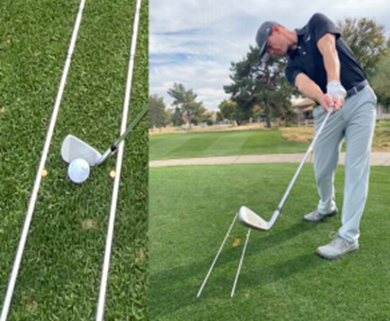Golf
Welcome and thanks for visiting...

Four Drills to Break 100

Students often ask me what it takes to hit different milestones in golf. The most common milestones are breaking 100, 90 or 80. Breaking 100 seems to be the most requested, so I thought I’d share my favorite drill for each of the four key components of the game - full swing, short game, putting, and mental / course management that will help you shoot in the 90s or even lower!
Full swing:
Golf improvement can be somewhat simple if you logically break down what needs to happen to get to a certain level of proficiency. When it comes to your golf swing all you need to do to break 100 is hit the ball solidly, hit it with a consistent shape, and know how far each club goes. Many golfers get caught up in fixing swing errors, especially if they slice. Obviously an extreme slice is problematic, and there are lots of ways to fix a slice if that’s a major problem for you, but if your natural shot is an “educated fade” and it’s not completely robbing you of distance then stick with it!

My favorite full swing drill is designed to improve your ability to control the low point of the golf club every swing. It will help you develop the ability to hit the ball first with your irons and make solid contact from heel to toe. A couple of simple tools set up on the driving range will help you. Place two alignment sticks on the ground parallel to each other about 1” wider than the clubhead and pointed directly at your intended target (slightly left of target if you like to fade the ball and slightly right of target if you like to draw the ball). Then take two tees and push them into the ground just on the inside edge of each stick. These are going to serve as markers to help you see where you contact the ground. The goal is to swing straight down the alley created by the two sticks without disrupting them while contacting the ground on the target side of the tees. Begin each practice session with 10 practice swings that “mark” the turf on the target side of the tees. Then, place the ball between the tees and start to hit some shots. If you can figure out how to hit the ground correctly while swinging on a consistent path you’ll be hitting the ball first, swinging on a straight path, and coming close to the center of the face from heel to toe. Start charting how far the ball is going with each club so that you have a good sense of how far each club goes as well. You can do this drill for every club up to the driver, which of course we don’t want to hit the ground. One other tip to help you consistently hit the ground in the same place is to keep the ball a little forward of the center of your stance for all full swing shots.
.jpg)
Short Game:
Easily the best short game drill I have is called the 10-spot game. Head over to the short game area at your practice facility. Take one or two balls, and every club from lob wedge up through your 8 iron with you, including your putter. You’ll keep them with you as you walk around the whole time. The goal of the drill is to play the ball into the hole from 10 different locations for a score. You should pick 3 hard locations (think lob shot over a bunker or thick rough to a tight pin), 4 medium locations, and 3 easy locations (basic chip near the green). Drop your ball at spot 1 from waist high and play it as it lies. Pick a hole location and play the ball into the hole including putting out. Continue to location 2 and so on, each time choosing which type of shot to play and putting out. This drill does a number of good things. It forces you to work on shot selection, which is ultimately pretty simple if you’re trying to break 100. From the easy spots you should be trying to get down in 2. From the medium and hard locations you should be trying to get down in 3. If you’re scoring lots of 4’s or worse you are likely trying to be too aggressive (getting “cute”) with your first shot, picking a shot that is too complicated, or three putting too often. After you’ve completed the 10 spots add up your total score and try to better it every session. Since the goal is to lower your score keep this strategy in mind: If you can putt it - putt it. If you CAN’T putt it - chip it. If you CAN’T chip it - pitch it. And if you CAN’T pitch it - lob it.

Putting:
I must like the number 10, because in addition to the 10-spot drill my favorite putting drill is the 10-point drill. Not to mention I always wear the number 10 when I play team sports - must be good luck. I like the 10-point putting drill because it’s extremely simple, requires no setup, and it improves every aspect of good putting - reading the green, lagging the ball close to the hole, and sinking short putts. Simply pick a hole to putt to that is anywhere from 30 to 80 feet - essentially long putts that aren’t likely to be holed. Do your best to read the green accurately and putt the ball into the hole. If you make the first putt or get down in two putts give yourself ONE point. If you three putt or worse take ONE point away. You have to stay on the green until you get to 10 points. Sounds easy, but if you don’t read the green well, don’t lag your first putts close, or if your 2-4 foot game is weak you’ll find that it’s easy to spin your tires and you’ll be out there a long time! The better you get at reading the green your lag putts and short putts will be better. The better you get with your distance control the short putts will get easier. The 10-point putting drill will help you take a few bucks off your buddies next time out!

Course Management / Mental:
If you spend a few weeks going through the drills I’ve outlined above, you SHOULD start to become proficient enough in the technical skills of hitting, wedging and putting a golf ball to be able to break 100. But even after improving technique, golfers can sometimes be held back because their mental game is weak and their course management skills are lacking. So my favorite course strategy game, Worst Ball, will help you improve consistency and force you to make conservative and smart decisions which will help you avoid big numbers. Making one or two triple bogeys instead of limiting the mistakes to bogey will typically be what derails your chances for that elusive 99. Worst Ball is best done later in the evening when you can get out to play a few holes by yourself and the course is a bit less crowded. It’s really very simple. Play your game as normal until you get within 120 yards of the green. At that point you hit two balls from every shot location and the worst result of the two shots is the one that you play from next. So if, for example, you find yourself in a greenside bunker and you hit the first ball nicely out onto the green you have to drop another ball and try to do it again. If that one blades over the green you have to go play two from that location, and so on. And if you make a clutch 6 footer for an up and down guess what? You have to make it again! You’ll find very quickly that a conservative strategy and a simple shot will help you get down in fewer strokes almost every time. The more aggressive plays should be left to the people who are trying to break 90 or 80.
I certainly hope that these drills will help you build the skills needed to crack the 100 code and even beyond! A few weeks of diligent work (2-3 times a week or more) should be enough to improve your ball striking, gain confidence in your short game and putting, and clean up your course strategy. You’ll see the big numbers start to go away, and your scores will drop in no time!
If you have any questions about these drills feel free to contact me at:
satherton@eaglesprings.org





